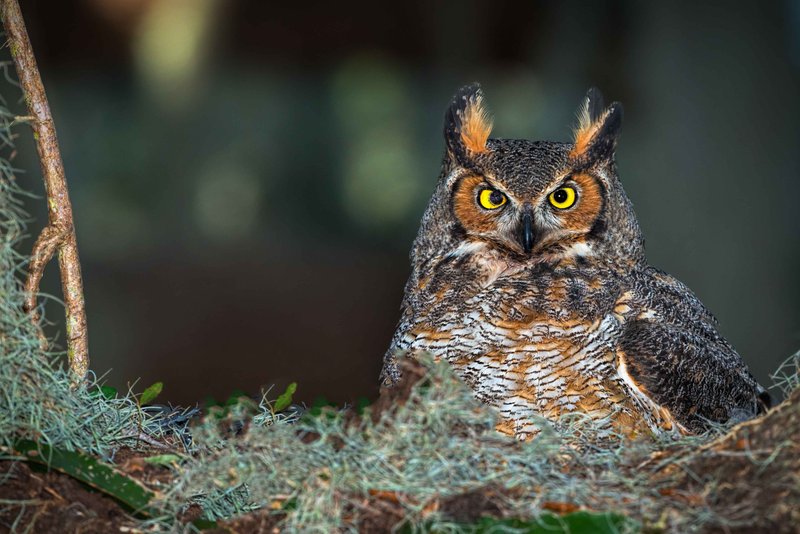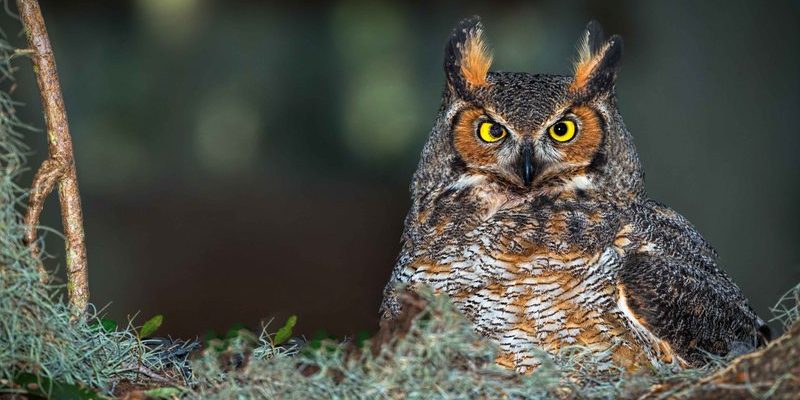
Great Horned Owls (Bubo virginianus) are often described as the “tigers of the night.” They’re known for their striking tufted ears and a powerful presence. From their choice of nesting spots to their life cycle, there’s a lot to explore. Let’s dive into their world, uncovering how they raise their young and the environment they thrive in.
Nesting Preferences
Great Horned Owls are pretty flexible when it comes to nesting places. You might find them in various habitats, from wooded areas to urban parks. They prefer high vantage points, which give them a good view of their surroundings. Think of it like setting up a home on the top floor of a building—you get the best view and a sense of security.
These owls often choose to nest in abandoned nests of other birds, especially large ones made by hawks or crows. They’re not picky! If an old nest works, they’ll use it. Sometimes, they even nest in trees, cliffs, or even on the ground if necessary. It’s all about making the best of what’s available.
Once they pick a spot, the female owl will line the nest with materials like feathers, grass, and sticks. This cozy touch is essential, especially for the eggs and hatchlings, keeping them safe and warm. Honestly, who wouldn’t want a comfy home like that?
Breeding Season
The breeding season for Great Horned Owls typically begins in late winter to early spring. It’s like a big, nightly celebration where hooting and courting behaviors ramp up. Males will often perform elaborate displays to attract a female, showcasing their strength and beauty. You might be wondering what this looks like—picture a bird puffing up its feathers and making deep, resonant calls that echo through the forest.
Once a pair forms, they’ll mate for life. They’re committed partners, which is pretty sweet in the bird world. After mating, females usually lay between 1 to 5 eggs—each one a little miracle. The eggs are usually white and have a slightly rounded shape. Interestingly, they don’t all hatch at the same time. This staggered hatching helps ensure that at least some chicks survive, even if food is scarce.
Incubation Period
Incubation for Great Horned Owl eggs lasts about 30 to 37 days. During this time, you can find the female sitting on the eggs, keeping them warm and safe. The male plays a vital role too, bringing food to the female and ensuring she stays well-fed. It’s like a team effort, where both parents share the responsibility of raising their young.
What’s fascinating is that during this period, the female will only leave the nest for short bursts to eat, drink, or stretch her wings. She’s incredibly dedicated, like a parent working tirelessly to create a secure environment for her future chicks. Imagine her sitting quietly, listening to the sounds of the forest, all while being vigilant against potential threats.
Hatching and the Chick Stage
Once the eggs hatch, it’s a time of excitement and vulnerability. The chicks, known as owlets, are born altricial, meaning they’re relatively helpless at first. They have soft, downy feathers, but they can’t fly or see properly right away. Here’s where the real nurturing begins.
The female keeps the owlets warm and starts to feed them small pieces of food, often brought by the male. The first few weeks are crucial as the chicks grow rapidly. They’ll start to gain strength and develop their feathers, preparing for their first flight. You might picture a little fluffball trying to flap its wings in excitement—so cute!
At this stage, they remain in the nest for several weeks, relying heavily on their parents. As they grow, they’ll begin to practice their wing flapping and explore their nest more. It’s like watching a toddler learn to walk—every small step is a big deal.
Fledging and Independence
After about 10 to 12 weeks, the owlets are ready to fledge, which is just a fancy term for learning to fly. You can imagine the anticipation in the nest as they stretch their wings and practice jumping around. This is a huge milestone; it’s when they start to try their wings and take those first flights into the world.
Once they leave the nest, it doesn’t mean they’re fully independent. The young owls will continue to rely on their parents for food and protection for a while longer. During this time, you might see them hanging around nearby, perfecting their hunting skills. It’s like a teenager slowly gaining independence but still needing parents for a little extra support.
As summer rolls around, the young owls will get better at hunting and become more self-sufficient. Eventually, they’ll disperse to find their territories, but they’ll always remember the lessons learned from their parents.
Lifecycle Longevity
Great Horned Owls typically have a lifespan of around 10 to 15 years in the wild. However, some have been known to live longer in captivity, sometimes reaching up to 28 years. Their lifespan can be influenced by various factors, including food availability and threats from predators.
In the wild, these owls face challenges like habitat loss, competition, and human interference. However, their adaptability helps them thrive in many environments. Here’s the thing: despite the natural hardships, Great Horned Owls continue to be a popular and resilient species.
As they age, their feathers can become more worn, and their hunting abilities may diminish. Yet, even in their later years, they contribute to the ecosystem, teaching younger generations and ensuring their lineage continues.
Great Horned Owls are truly remarkable creatures with fascinating nesting habits and an engaging lifecycle. From their clever nesting strategies to the heartwarming way they raise their young, there’s so much to appreciate about them. They show us the beauty of nature’s design, where every detail matters, and every creature plays a role.
So, next time you hear an owl’s call on a quiet night, take a moment to think about its intricate life. These magnificent birds deserve our admiration and protection, reminding us of the delicate balance of life in the wild. Whether you’re an owl enthusiast or simply someone curious about nature, understanding their nesting habits and lifecycle offers a glimpse into the wonders of wildlife.

